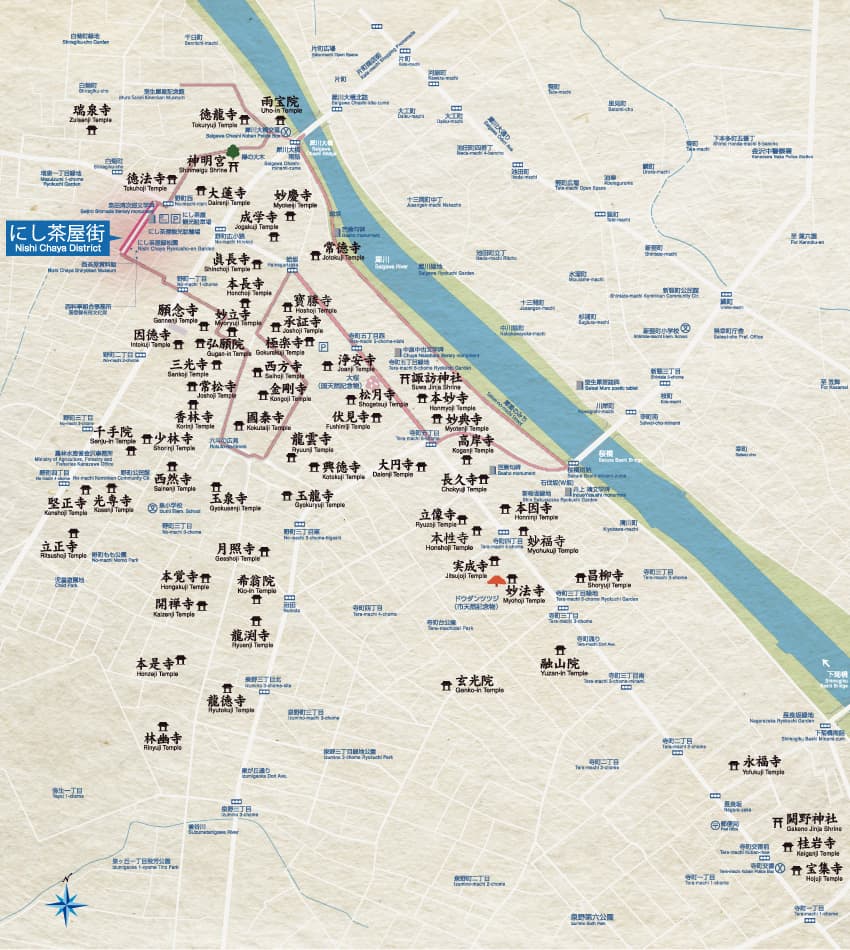Teramachi temple area in the southwest
Teramachi town is the biggest of the three temple areas in Kanazawa and has about 70 temples and shrines, including Myoryuji Temple, also known as Ninja Temple;, Syogetsuji Temple, which has a big cherry tree that is, a nationally designated natural monument;, and Daienji Temple, which enshrines the gGuardian deity for children made from human bones used to pray for a long life. Each of them has its own history and storytale, giving us the atmosphere that matches the town’s area’s name of “Teramachi.”
Teramachi also lets us hear the sound of temple bells every Saturday evening, a sound that was selected as one of “the 100 best sounds we want to leave for the future.” It is interesting to visit and see the many literary monuments on the temple grounds and on the roadside, or to explore the Nishi Chaya District, with its lattice doors and cobblestones.

Three Temple Areas of Kanazawa
Around 1616, the third lord of the Kaga clan, Toshitsune Maeda, gathered the temples that were scattered around Kanazawa into three areas of Kanazawa. There were several reasons for this: to defend Kanazawa Castle, to control the temples, to keep a register of the population, and to counteract the rioting of the Ikko Sect of Buddhism. The three temple areas are Kodatsuno in the southeast, Utatsuyama in the northeast and Teramachi in the southwest. Each area has its own distinctive atmosphere and presents an aspect of Kanazawa that will likely be new to you. To start with, how about deciding on the temple that you would most like to visit, and walking around the neighborhood?
Muro Saisei Kinenkan Museum
A museum where you can touch the works of the writer Muro Saisei, who loved his hometown of Kanazawa. Near Uhoin Temple, there stands a museum at the birthplace of Muro Saisei. It displays valuable materials such as Saisei’s chronological record, and his hand-written manuscripts and letters, allowing us to touch his life styleway of life and character. More than 150 bindings are displayed in a soaring lobby, which is also worth seeing.
Nishichaya Shiryokan Museum
It introduces the life of Shimada Seijiro, who wrote the bestselling-book Chijo in the Taisho era. The museum was constructed at the west end of the Nishi Chaya District at the former site of Chaya Yoshiyonero, where Simada Seijiro spent his boyhood. On the first floor, various materials related to Seijiro are displayed, while on the second floor, lined with vermilion-lacquered walls and golden folding screens, you can enjoy the tea house atmosphere of days gone by. In the show window next to the entrance, Kaga lion-dance costumes are displayed.
Teramachi Temple District – the area filled with an atmosphere of literature
Muro Saisei, one of the three great writers of Kanazawa, was adopted to Uhoin Temple right after his birth and spent his boyhood there. His lonely background was said to affect his works all through his life.
Many of his works are set in Kanazawa. Shimada Seijiro, born in Mikawa Town (now Hakusan City), moved to Chaya “Yoshiyonero” (now Nishichaya Shiryokan Museum), run by his grandfather, before entering elementary school. In 1919, at the age of 20, he became a best-selling writer with his autobiographical novel Chijo. However, he died at the mere age of 31. The poet Nakahara Chuya spent his pre-school days in Kanazawa (his famous poem “Circus,” was based on his memories of Shinmeigu Shrine from that time). Another writer, Inoue Yasushi, used to walk the W-zawa slope when he was a student, and there lies a stone tablet with a passage from his autobiographical novel The North Sea.
Saisei road
As you walk along the Saisei road toward O-Hashi you will see old willows and cherry trees moving in the breeze.If you are lucky,you may get a sense of whet an enjoyable place this has been for many pegoce. In this area there is the doubce-zaka slafe.YasushiInoue used to walk along this slope on his way to shiko school.On the slope there is a monument to his autobiographical norel The North sea.
Visiting stone tablets with Matsuo Basho’s haiku
In 1689, the poet, Matsuo Basho, started his trip “‘The Narrow Road to the Deep North”’ accompanied by his disciple, Sora. He stayed in Kanazawa about 10 days and wrote many haiku. In the Teramachi Temple areaDistrict, we can see some of his poems.

